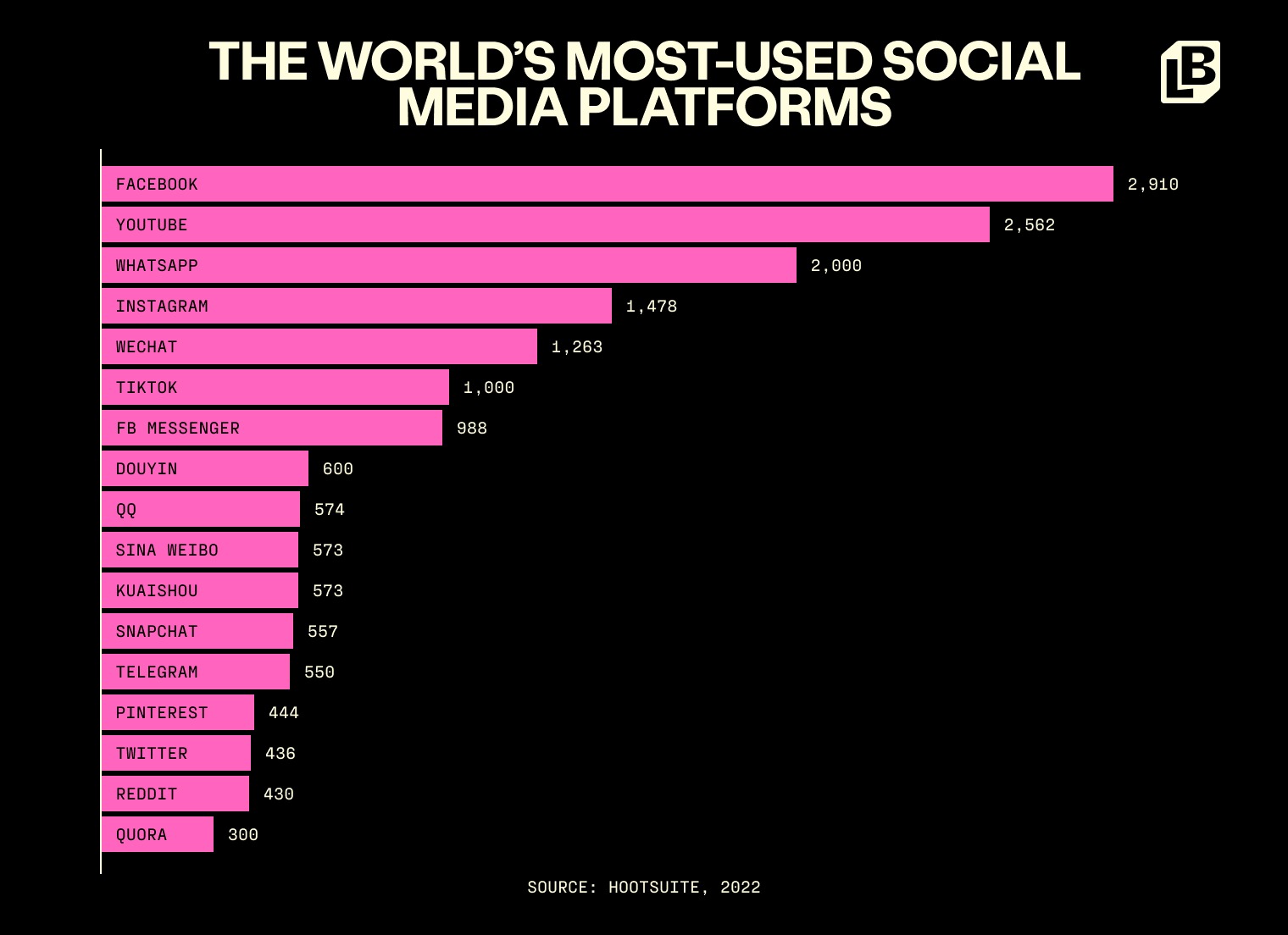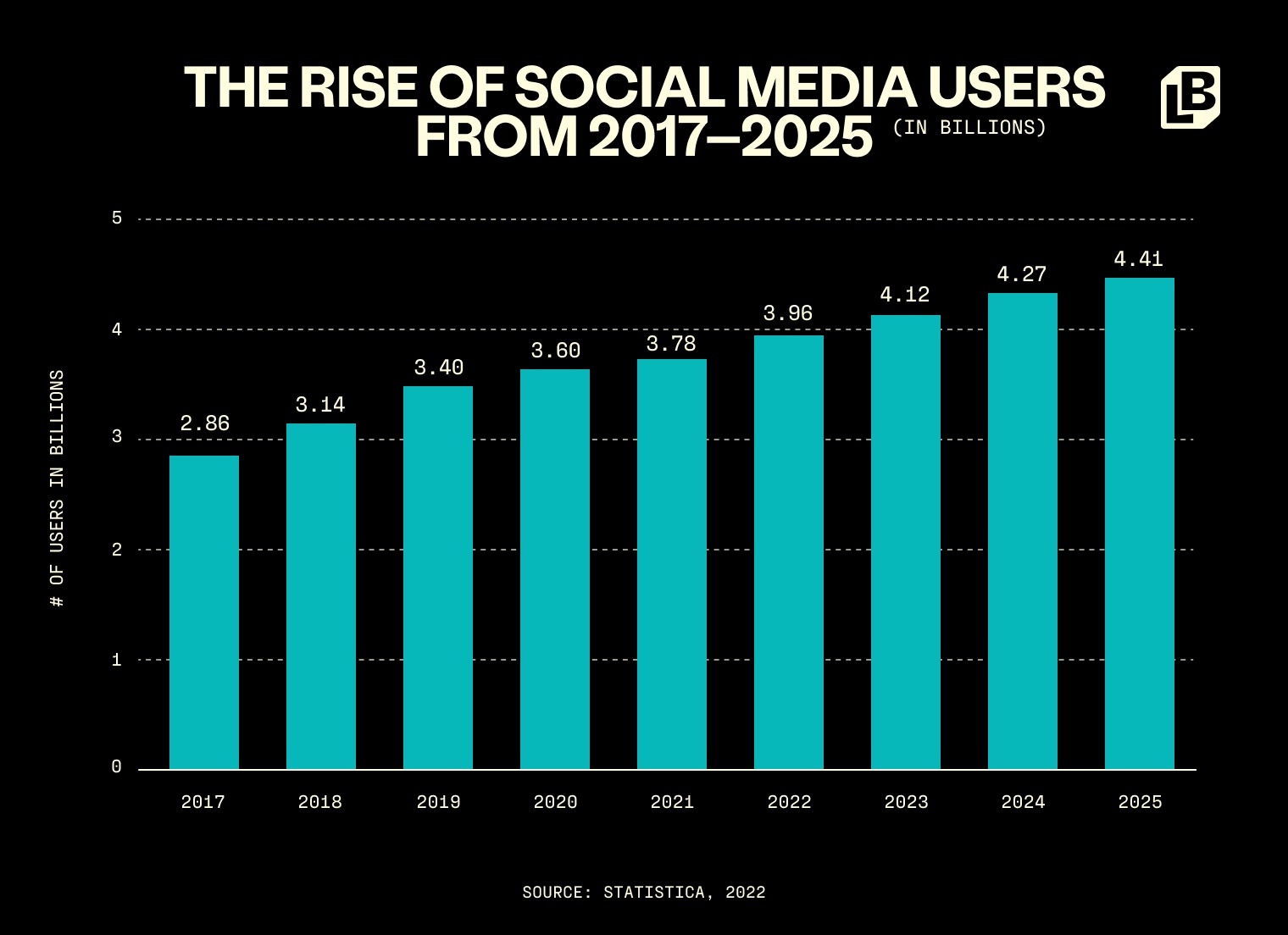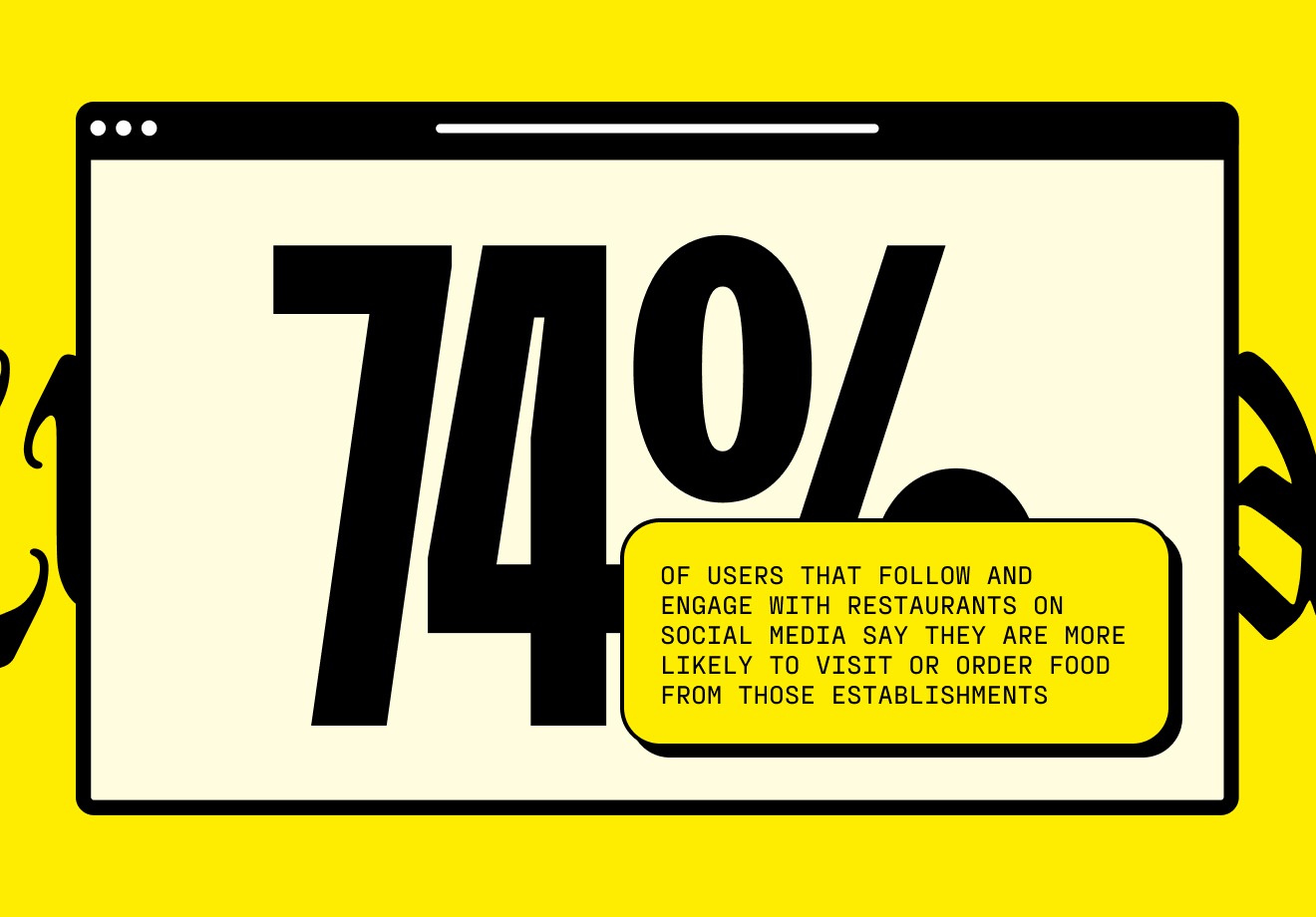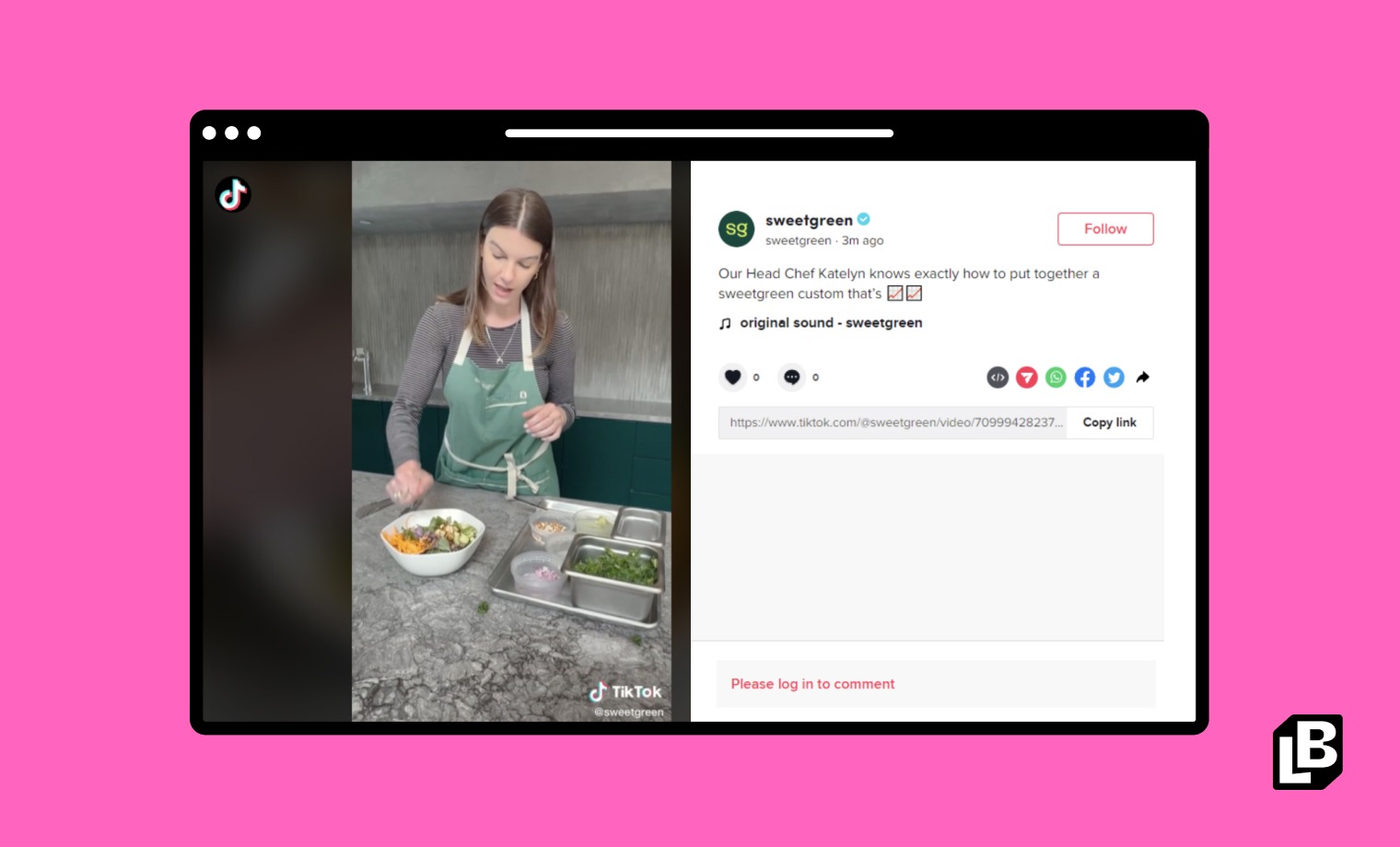Share
- Jump to:
If your restaurant business isn’t on social media, then you’re missing out on new and current customers. Simply put, your customers are on multiple social media platforms, and you should be too. It’s one thing to have an online presence with a website and Google/Yelp reviews, but also having a social media presence will boost your brand awareness to the next level.
Social media is free (for the most part) and easy to use, so, therefore, it should absolutely be a part of your marketing plan. In fact, approximately 63 percent of restaurants use social media as their main method of advertising.

Although not all social media platforms are ideal for restaurant business, here are the world’s most-used social media platforms. Source: Hootsuite, 2022
Over 3.6 million people worldwide were using social media in 2020. The potential for reaching new customers via social media is massive. MGH, a full-service restaurant marketing agency, conducted a survey that found that 45 percent of U.S. diners said they’ve tried a restaurant for the first time due to a social media post made by the establishment.

The rise of social media users from 2017-2025 (in billions). Source: Statistica, 2022
You might choose to actively post every day on multiple platforms, or simply post an updated menu to your Facebook page. There are multiple ways to go about social media marketing for restaurants, but it is better to do a little rather than none.
Why Is Social Media Important For Restaurants?
Social media hasn’t always been a part of marketing, of course. In the past, paid advertisements, signs, flyers, word of mouth, and customers walking by were the best way to gain awareness about your restaurant. While some restaurants may still rely on these forms of marketing, social media can assist in reaching target demographics
Allows users to find information about your restaurant.
A website and online reviews are one way that customers can learn about your restaurant. Social media allows customers to get a more intimate, updated look into your restaurant. You should keep your website updated frequently, but chances are you’re not updating it every day or multiple days a week. Social media is quick and easy enough to use that you could post this frequently and share updates with your customers.
For example, if your restaurant is closing early one day, this would be best to post to all social media channels. Your followers will see this, but it’s likely they wouldn’t check your website and see this. If your restaurant sells out often, this is something that can be posted to social media to let your customers know quickly.
Yelp and Google are good ways for customers to see photos and reviews of your menu items. However, the reviews and photos may be a few months old. With social media, you can post recent photos of your food and highlight new dishes as soon as they are available.
Social media is one place for you to share contact information, like a phone number and email. It would also make sense to list your operating hours and any special holiday hours.
It’s a great way to highlight and differentiate your brand.
With social media, you can create a particular aesthetic for your brand. This is especially true on visual-heavy platforms like Instagram and Tik Tok. To stay “on-brand” choose the same colors or style found in your restaurant. For example, a minimalist modern coffee shop may choose to share simple close-ups of coffee and black and white shots.
What makes your brand stand out? What audience do you appeal to? Keep these questions in mind when posting on social media. For example, a taqueria could post in a mixture of English and Spanish to appeal to its
Opens communication with customers.
If someone on your team is in charge of social media and is actively on it, this can be one way for your restaurant to connect with its customers. Younger generations are accustomed to sending messages (rather than making phone calls), and social media provides an instant way to send a question or comment to a restaurant. According to restaurant marketing agency MGH, 74 percent of users that follow and engage with restaurants on social media say they are more likely to visit or order food from those establishments.

Adds professionalism and legitimacy to your restaurant.
Customers like to do due diligence on restaurants before choosing to dine there, and social media can certainly help with their search. Checking out your restaurant’s website and Google ratings is a great place to start, but social media can provide important details about your restaurant that customers can’t find anywhere else. This is where you can post specials, beautifully plated dishes, favorite customers, your great staff and more. With social media platforms, your restaurant appears more established, especially if you post frequently and have garnered a decent following.
Allows users to share their experiences with others.
When eating out at restaurants or drinking at a bar, younger generations like to share their experience with their followers. This is especially common on Instagram (where users may share a post or story), Tik Tok, and Snapchat. If your restaurant has an account on Instagram or Tik Tok, users can tag your social media handle, which allows other users to click and go directly to your account. This is similar to word-of-mouth marketing, which is extremely effective at bringing in new customers.
Top Social Media Platforms for Restaurants
The more platforms you use, the stronger your social media presence will be. Of course, you’ll want to keep in mind who exactly your customer base is when choosing what platforms to use. Your restaurant’s marketing strategy should include using multiple social media platforms to reach the maximum potential customers.
Facebook.
If your business targets older generations, Facebook is the social media platform to market to them. According to Pew, 62 percent of internet users ages 65 and older use Facebook. This social media platform has existed longer than other social media apps, and has therefore been used by older generations for longer. With Facebook, your restaurant can create a business page and then invite users to “like” and “follow it” for updates. Using the platform’s comprehensive business manager, you can pay to boost certain posts and create targeted ads to get your restaurant in front of more users. Read more about using Facebook for your restaurant here.
If your business targets GenZ and Millennial users, consider using Instagram and Tik Tok instead.

Holy Matcha, located in San Diego California, is known for its very “Instagrammable” green and pink interior. Source: Holy Matcha, 2022
Instagram.
In recent years, it has become more popular for food and beverage establishments to become more “instagrammable”. This could mean a combination of things: trendy murals to take photos in front of, neon signs with catchy slogans, eye-catching wallpaper, and out-of-the-box decor. Some restaurants choose a simple, sleek, modern interior with colorful dishes and adorned beverages. Foodies and influencers alike will come flocking to your establishment to take aesthetic photos for the ‘gram.
When your restaurant shares an Instagram post, be sure to use hashtags (especially trending hashtags that users are clicking on!). This helps users who do not follow you discover your account. It is especially important to use hashtags for your type of cuisine (like #veganfood, #BBQ, or #italianfood), as well as location tags (such as #Austinfood, #LArestaurants, or #eatAtlanta). All photos and videos can also include a location, so be sure to add your restaurant name here. If a customer clicks on the location/restaurant name, it brings them to a feed that shows all of the photos and videos linked taken at your establishment, as well as its location on the map.
Lastly, Instagram stories can be used to give exclusive, behind the scene looks into your establishment. You can take quick videos of chefs cooking, bartenders working their magic, and fresh produce being delivered to the kitchen to create your dishes.
Twitter.
As a more word-forward platform, Twitter is a great way to blast out quick tweets about new menu items, special deals, events, or key features of your restaurant. If you operate a food truck or pop-up operation, Twitter can help you get the word out about when and where you will be serving food next. You can post videos and photos to the platform as well, so this is another way to highlight your establishment’s dishes and limited-time offerings.

On Sweetgreen’s TikTok account, the company’s head chef demonstrates how to create a custom bowl. Source: Sweetgreen, 2022
TikTok.
TikTok is best for marketing to younger generations like GenZ and GenX. This platform is video only, so this is a great place to highlight up-close clips of your best dishes, behind-the-scenes preparations, your staff in action, and any live events happening at your restaurants. Trending sounds and songs are added to your posts to get your videos in front of more viewers. This platform also uses hashtags, so this is another way to get more people to your account. Be sure to hashtag your location so visitors and locals on this platform see your restaurant pop-up on the explore page.
Pinterest.
Many Pinterest users go on the platform specifically looking for food inspiration and recipes. Even if users don’t follow your account here, posting tantalizing photos of food and beverages can draw them to your account via Pinterest’s discovery page. The key to this platform is posting eye-catching photos without relying on detailed captions. Be sure to use appropriate tags on your post so those searching for something specific will land on your post. Often, users are scrolling through this platform quickly, and will only pause very briefly to “pin” something they like to their own boards.
Social Media Marketing Ideas for Your Restaurant
When it comes to social media marketing ideas for your restaurant, the possibilities are endless. This is really an arena to let you and your staff’s creativity shine. Pay attention to social media trends, while also experimenting with novel ideas. Certain tactics may work better for certain platforms; for example, giveaways work really well on Instagram, while driving email sign-ups would be better for Twitter and Facebook.
Post photos and videos of your food.
This is one of the most obvious things you can post to social media, but it can be the most effective. Customers are going to your restaurant to eat and drink, and sharing those mouth-watering close-ups of menu items and delectable drinks can tempt them to come in. Try experimenting with different angles; try close-ups of different dishes, or maybe snap a shot of a full table spread. Post a video of sizzling fajitas being plated (sound on!) or a cocktail being shaken and poured.
Highlight your employees.
Good service plays a major role in if customers want to return to your restaurant. This is especially true for regular customers because they will quickly get to know your staff. Seeing favorite staff members being highlighted on your social media accounts they follow builds a sense of community and connection.
Feature customers.
Customers appreciate being recognized by staff as regulars, and featuring them on your social media can go one step above this. Feature your customers to show that you do care about them, and that they are a key part of your business. This is another way to showcase your menu items as well; showcasing customers eating and drinking makes your content seem more realistic and relatable.
Work with influencers.
Micro-influencers typically have 5,000-10,000 followers, while regular social media influencers have anything above that. Their jobs are essentially to post for a brand or company on social media, and they get paid per post. Some influencers, especially those with smaller followings, may accept payment in the form of a free meal; this is one way to increase brand awareness around your restaurant. Influencers typically use platforms such as Instagram, TikTik, and YouTube. Their title describes exactly how they can help your business; these figures influence social media users to engage with your account and visit your restaurant in real life.

@shutthekaleup is an Instagram influencer that posts about food, health, and wellness. Although this is an unsponsored post, you can see the level of engagement this post about Sidecar Doughnuts & Coffee garnered. Source: @shutthekaleup, 2021
Utilize user-generated content.
User-generated content is like paying someone to take candid photos and reviews of your restaurant and what it offers…except you don’t need to pay for it! User-generated content is an excellent way to get free content from your customers that can be reposted to your own social media accounts. This type of content is authentic and honest, and is appealing for other customers to see. How do you encourage users to post their own content? You can consistently repost their content to your own account. Or, you can offer incentives for reposting.
Highlight deals and promotions.
Physical coupons are out, but social media promo codes and deals are in. Consider offering followers exclusive deals that only they receive. If customers follow you on social media, you can offer a special deal, like a free cookie or beverage. You can post this directly to your story. Social media is the perfect place to get the word out about limited-time menu items or nightly specials.
Drive email sign-ups and followers.
On social media, you can encourage your followers to sign up on your website with their email. When your restaurant has access to emails, you can directly market to these customers. Email blasts can be sent out about promotions, special events, and new menu items. If you have more information on the customer, such as their birthday or order preferences, personalized emails can be sent out.
Respond to reviews and feedback.
Being on top of responding to reviews and feedback shows that your restaurant truly cares about its customers and that what they have to say matters. Reading, understanding, and responding to reviews helps your restaurant grow. This is the best way to learn about what your restaurant needs to improve upon. It is crucial to respond to all bad feedback and reviews customers might share on social media; left unanswered, this customer may never give your restaurant a second chance. An unanswered negative review will signal to other customers that your establishment isn’t willing to make your wrongs, right.
For social media management, it is also important to respond to positive feedback and commentary as well. More comments and activity on your social media page means more follower engagement, boosted SEO, and customer loyalty.
Have contests.
Similar to highlighting deals and promotions, a social media contest is an incentivizing tactic to encourage your customers to follow you and engage with your account. Users can comment on or share your post for entries to give away. When customers share your post to their own social media, this gets your account in front of many more eyes. Your restaurant can partner with influencers or other local restaurants and brands to host a partnered contest, which helps bring in new followers to each other's accounts. As a prize, your restaurant can offer gift cards that will bring social media users into your restaurant.
Conclusion
In the highly competitive restaurant industry, establishments are always vying for the same customers. Social media is one tool that can be used to help your business stand out by showcasing the highlights of your restaurant and creating a greater online presence. Creating social media profiles across multiple platforms should be a major part of your restaurant’s digital marketing strategy, especially since it is mostly free. Each restaurant’s social media strategy will vary based on who its target customer is, and developed based on this. With such a massive amount of users on social media, this is a no-brainer marketing tool that should be used to draw in new customers and connect with existing ones.